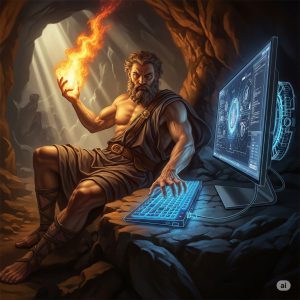
Why focus on the question of humanity’s future in a technological age this season?
For two reasons: Technology is pervasive and disruptive.
We are going to set up the season by discussing two stances, three stories, and one big idea.
Two basic Stances
There are two basic postures, or stances, that one can take toward the world. The philosopher David McPherson describes these basic postures, or “existential stances” as “an orientation towards the world as it is, i.e., towards the given.”[1] He goes on to offer the following two basic postures.
First, there is the choosing-controlling stance. Second, there is the accepting-appreciating stance.[2]
Three Basic Stories
The first basic story is perennial naturalism. On this story, all that exists is matter. Man’s fundamental problem if they are vulnerable to the world (and each other) and the solution is mastery and buffering of self through science and technology. Given the new technological age we find ourselves in, we can call this story, following Tara Isabella Burton, the “techno-utopian story.”[3] This story functions as a kind of secular religion, first for the elites, but now for the masses, as we’ll see.
The second story is a more refined version of what might be called the postmodern story or the creative-anti-realist story. On this story, in the beginning there is pure nature and the unfettered human will. The central problem of humanity is oppression, particularly to religious dogma and its resultant morality. The solution is freedom from limits and the unfettered expression of human power, will, and creativity (often art functions as a new religious ideal in the place of God). The world is a blank canvas and so are we—we can create by exerting our supreme will. We’ll call (uncreatively) Nietzschean utopianism.
The final story is the Christian story. It is a story that begins and ends with God. It is a story in which humans are created by God as divine image bearers-priests and priestesses of the world who receive all things from God, steward and care for all things, and then re-gift them back to God. On this story, we find in the cultural mandate in Genesis 1 the call to develop society and technology, but to do it in a way that accepts the givenness of all things. We find in Genesis 2 the call to work and care for the garden, and by extension, all the world as we take up our place as stewards of the world.
Big idea
Where you stand and how you lean determines who you become and how you behave.
This is true of individuals, and this is true of culture and society as well.
 [1] David McPherson, “Human Philosophy as Public Philosophy: A Path for Religious Engagement in Public Life,” Proceedings of the ACPA, Vol. 92 (2018): 144.
[1] David McPherson, “Human Philosophy as Public Philosophy: A Path for Religious Engagement in Public Life,” Proceedings of the ACPA, Vol. 92 (2018): 144.
[2] Ibid.
[3] Tara Isabella Burton, Strange Rites (New York: Public Affairs, 2020), 189–199.



